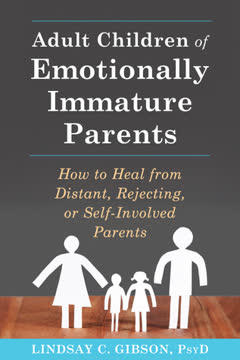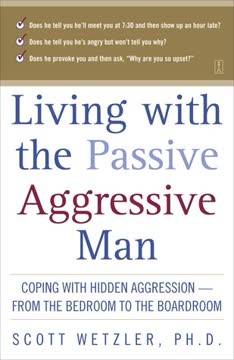Key Takeaways
1. Passive-aggression is anger expressed indirectly
The passive-aggressive man is simultaneously passive and aggressive.
Indirect hostility. Passive-aggressive men express anger covertly through:
- Procrastination and "forgetting"
- Silent treatment and withdrawal
- Subtle insults and criticism
- Sabotage and obstruction
Denial of anger. They often deny feeling angry, instead:
- Claiming innocence or good intentions
- Accusing others of overreacting
- Portraying themselves as victims
This indirect expression of hostility allows passive-aggressive men to avoid taking responsibility for their anger while still acting on it. The result is confusing and frustrating for those around them.
2. Passive-aggressive men fear intimacy and dependency
To comply ("Be a good boy, and …") is proof of his weakness, and by refusing to heed his parents' wishes, many a passive-aggressive man starts his pattern of being contrary, especially to authority.
Fear of vulnerability. Passive-aggressive men are deeply afraid of:
- Emotional intimacy and closeness
- Being dependent on others
- Losing control in relationships
Contradictory behavior. This fear leads to:
- Push-pull dynamics in relationships
- Difficulty committing or following through
- Sabotaging closeness when it develops
Passive-aggressive men long for connection but are terrified of it. They use their behavior to keep others at a "safe" distance, protecting themselves from perceived threats to their autonomy and self-sufficiency.
3. Childhood experiences shape passive-aggressive behavior
Growing up with passive-aggressive men may unconsciously trip you into encouraging it in other men—as much as you dislike it.
Parental influences. Key childhood factors include:
- Overly controlling or emotionally unavailable parents
- Inconsistent discipline and mixed messages
- Lack of healthy role models for expressing anger
Learned coping strategy. Passive-aggression develops as a way to:
- Assert independence from domineering parents
- Express anger safely in a punitive environment
- Gain a sense of control in powerless situations
Understanding the roots of passive-aggressive behavior can foster empathy. However, it doesn't excuse the behavior in adults, who must take responsibility for their actions and their impact on others.
4. Women often enable passive-aggressive behavior
If you grow up with a father or brother, or both, who are passive-aggressive, you're pretty much at the mercy of their machinations when you're young.
Common enabling patterns:
- The Victim: Accepts mistreatment, blames herself
- The Rescuer: Tries to "fix" the passive-aggressive man
- The Manager: Attempts to control and change him
Unconscious motivations. Women may enable because:
- It feels familiar from childhood experiences
- They fear abandonment or being alone
- They believe they can "save" the man
Recognizing these patterns is crucial for breaking the cycle. Women must examine their own role in perpetuating passive-aggressive dynamics and learn to set healthy boundaries.
5. Communication and limit-setting are key to managing passive-aggression
Limit setting is the policeman's role—to safeguard you from the destructive impact of his behavior.
Effective communication strategies:
- Be specific about behaviors, not character
- Use "I" statements to express feelings
- Avoid accusations and generalizations
Setting and enforcing limits:
- Clearly state expectations and consequences
- Follow through consistently
- Be prepared for pushback and testing
Encouraging directness. Help the passive-aggressive man:
- Identify and express feelings openly
- Take responsibility for actions
- See the benefits of clear communication
Consistently applying these strategies can create a safer environment for honest interaction and gradually reduce passive-aggressive behavior.
6. Passive-aggression affects relationships, sex, and parenting
The passive-aggressive man doesn't fundamentally change when he becomes a father.
Relationship impact:
- Erosion of trust and intimacy
- Chronic misunderstandings and conflict
- Emotional distance and disconnection
Sexual difficulties:
- Using sex as a weapon (withholding or teasing)
- Performance anxiety and erectile issues
- Difficulty with emotional vulnerability during intimacy
Parenting challenges:
- Inconsistent discipline and follow-through
- Difficulty setting appropriate boundaries
- Modeling unhealthy communication patterns
Addressing passive-aggression is crucial for building healthy, satisfying relationships and creating a positive family environment. It requires ongoing effort and often professional help.
7. Workplace passive-aggression manifests as sabotage and obstruction
Since passive-aggression is fundamentally about power and control, it's not surprising that the passive-aggressive man constantly gets into power struggles at work.
Common workplace behaviors:
- Chronic tardiness and missed deadlines
- "Forgetting" important tasks or information
- Subtle undermining of colleagues' efforts
- Resistance to authority and direction
Impact on career:
- Difficulty advancing due to unreliability
- Creating a toxic work environment
- Damage to professional relationships
Management strategies:
- Clear, documented expectations and deadlines
- Consistent accountability for performance
- Addressing problematic behavior promptly
Recognizing and addressing workplace passive-aggression is essential for maintaining productivity and a positive professional atmosphere.
8. Change is possible but requires awareness and effort
Change isn't easy—and trying to change another without his consent is practically impossible.
Steps for the passive-aggressive man:
- Recognize the behavior and its impact
- Take responsibility for actions and feelings
- Learn healthier ways to express needs and anger
- Practice direct communication and assertiveness
Support from others:
- Encourage self-reflection and growth
- Provide positive reinforcement for direct communication
- Maintain boundaries and expectations
Professional help:
- Individual therapy to address underlying issues
- Couples counseling for relationship dynamics
- Anger management or assertiveness training
Change is a gradual process that requires commitment from the passive-aggressive individual and support from those around him. With persistence and the right tools, it is possible to develop healthier patterns of interaction and emotional expression.
Last updated:
FAQ
1. What is "Living with the Passive-Aggressive Man" by Scott Wetzler about?
- Focus on hidden aggression: The book explores the concept of passive-aggressive behavior in men, particularly how it manifests in relationships, workplaces, and families.
- Psychological analysis: Wetzler provides a psychological framework for understanding why some men express anger and resistance indirectly rather than openly.
- Real-life examples: The book uses case studies and composite stories to illustrate the impact of passive-aggressive men on those around them.
- Practical guidance: It offers strategies for women (and others) to recognize, cope with, and respond to passive-aggressive behavior in their lives.
2. Why should I read "Living with the Passive-Aggressive Man" by Scott Wetzler?
- Relationship improvement: The book helps readers identify and address passive-aggressive patterns that may be undermining their relationships.
- Self-empowerment: It provides tools for setting boundaries, protecting oneself, and making informed decisions about staying or leaving a relationship.
- Insight into male psychology: Wetzler explains why some men develop passive-aggressive traits, offering empathy and understanding rather than just blame.
- Actionable advice: Readers receive concrete steps for communication, limit-setting, and, if necessary, ending toxic relationships.
3. What are the key takeaways from "Living with the Passive-Aggressive Man"?
- Definition and recognition: Passive-aggressive men express hostility indirectly, often through procrastination, forgetfulness, and ambiguous communication.
- Root causes: These behaviors often stem from childhood experiences, fear of dependency, fear of intimacy, and unresolved anger.
- Impact on others: Passive-aggressive men can cause confusion, self-doubt, and emotional turmoil in partners, family, and colleagues.
- Coping strategies: Setting clear boundaries, confronting specific behaviors (not character), and, if needed, seeking therapy are essential for change.
4. How does Scott Wetzler define passive-aggressive behavior in men?
- Simultaneous passivity and aggression: Passive-aggressive men are not alternately passive and aggressive, but express both at the same time, often denying their aggression as it happens.
- Indirect hostility: Their anger is hidden under a facade of innocence, compliance, or forgetfulness, making it hard to confront directly.
- Mixed messages: They often communicate in ambiguous ways, leaving others unsure of their true intentions or feelings.
- Chronic patterns: Behaviors include procrastination, obstructionism, chronic lateness, selective forgetfulness, and playing the victim.
5. What are the main traits of a passive-aggressive man according to "Living with the Passive-Aggressive Man"?
- Fear of dependency and intimacy: He resists closeness and relies on indirect methods to maintain distance.
- Obstructionism and chaos: He may deliberately delay, forget, or complicate tasks to frustrate others.
- Victim mentality: He often feels unfairly accused and sets himself up as the innocent party.
- Excuse-making and lying: He fabricates reasons for not fulfilling obligations and avoids direct answers.
- Procrastination and ambiguity: He has a poor sense of time, is chronically late, and communicates in vague terms.
6. Why do some men become passive-aggressive, according to Scott Wetzler?
- Childhood experiences: Early deprivation, inconsistent parenting, and unresolved conflicts with authority figures (especially parents) contribute to passive-aggressive tendencies.
- Fear of confrontation: These men often fear direct expression of anger or needs, associating assertiveness with negative consequences.
- Dependency conflicts: They struggle with wanting support but fearing the loss of autonomy, leading to indirect resistance.
- Social and cultural factors: Changes in gender roles and expectations can leave some men feeling powerless, fueling passive-aggressive responses.
7. How does passive-aggressive behavior affect relationships, as described in "Living with the Passive-Aggressive Man"?
- Emotional seesaw: Partners often feel confused, doubting themselves, and are manipulated into taking responsibility for the man's behavior.
- Communication breakdown: Important issues remain unresolved due to avoidance, denial, and ambiguous responses.
- Erosion of trust: Chronic lateness, broken promises, and selective memory undermine reliability and intimacy.
- Cycle of frustration: Partners may become angry or controlling, which in turn reinforces the man's passive-aggressive tactics.
8. What types of women are most likely to be drawn to passive-aggressive men, according to Scott Wetzler?
- The Victim: Women with low self-esteem who tolerate or excuse mistreatment, often repeating patterns from childhood.
- The Manager: Women who try to control or "fix" their partners, unable to accept "no" for an answer, inadvertently fueling resistance.
- The Rescuer: Women who take on a caretaker role, over-functioning and enabling the man's dependency and avoidance.
- Shared dynamics: These roles often develop unconsciously and can be changed through self-awareness and boundary-setting.
9. What strategies does "Living with the Passive-Aggressive Man" recommend for coping with or changing passive-aggressive behavior?
- Set clear boundaries: Be specific about expectations and consequences, and consistently enforce limits.
- Focus on behavior, not character: Address specific actions rather than making global criticisms.
- Avoid enabling: Resist the urge to rescue, manage, or excuse the man's behavior; let him experience the consequences of his actions.
- Consider therapy: Encourage professional help if the behavior is deeply entrenched and causing significant harm.
10. How does passive-aggressive behavior manifest in the workplace, according to Scott Wetzler?
- Obstructionism: Passive-aggressive men may sabotage projects, withhold information, or create unnecessary delays.
- Excuse-making and buck-passing: They often blame others or circumstances for their lack of productivity or mistakes.
- Avoidance of responsibility: They may refuse to make decisions, procrastinate, or undermine authority figures (especially female bosses).
- Impact on morale: Their behavior can demoralize teams, foster mistrust, and hinder organizational effectiveness.
11. What does Scott Wetzler say about intimacy, sex, and marriage with a passive-aggressive man?
- Fear of closeness: Passive-aggressive men often withdraw emotionally or physically when intimacy increases.
- Sexual games: They may use sex as a battleground, withholding affection or engaging in teasing, abstinence, or other indirect power plays.
- Marriage challenges: Passive-aggressive husbands may avoid accountability, resist compromise, and retreat into solitude, making partnership difficult.
- Parenting issues: As fathers, they may avoid discipline, make empty promises, or compete with children for attention.
12. What are the best quotes from "Living with the Passive-Aggressive Man" by Scott Wetzler and what do they mean?
- "Passive-aggressive men don’t play fair. A Mark, a Jack or an Eddie may respect, be fond of or even passionately love the women in their lives, but the women don’t know it."
Meaning: The indirectness of passive-aggressive men leaves partners uncertain about their true feelings, undermining trust and intimacy. - "The key to his personality is the fear underlying his aggression. Once you know this, you’ll be empowered to act differently and try to change the relationship, or decide to leave."
Meaning: Understanding the root of passive-aggressive behavior (fear) gives partners the power to make informed choices. - "Change isn’t easy—and trying to change another without his consent is practically impossible."
Meaning: Real change requires willingness from the passive-aggressive man; partners can only control their own responses. - "The secret of dealing with a passive-aggressive man is to correct this misperception, and help him to feel more empowered."
Meaning: Addressing the underlying sense of powerlessness can reduce passive-aggressive behavior and improve relationships.
Review Summary
Living with the Passive-Aggressive Man receives mostly positive reviews, with readers finding it insightful and validating. Many appreciate the detailed descriptions of passive-aggressive behavior and its impact on relationships. Some reviewers found the book life-changing, while others felt it lacked practical advice for dealing with passive-aggressive partners. Critics noted gender stereotyping and over-generalization. Overall, readers found the book helpful in recognizing and understanding passive-aggressive behavior, though some wished for more concrete solutions.
Similar Books









Download PDF
Download EPUB
.epub digital book format is ideal for reading ebooks on phones, tablets, and e-readers.




